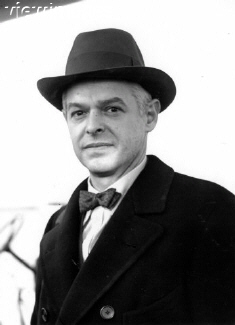
Cold War |

Paul Nitze, author of NSC 68
| In 1947, the journalist and commentator Walter Lippmann penned an article describing the developing US-USSR confrontation as a "Cold War." The term came to describe the state of superpower relations for the next four decades. This class focuses on the foreign policy aspects of how the Cold War was waged. |
Background:
The end of World War II saw two major powers dominating the European scene: the United States, whose troops liberated the western half of the continent; and the Soviet Union, whose Red Army had driven the Germans from eastern and east-central Europe. Europe thus was in many ways a divided continent even before the Cold War dawned.
| In addition, the two sides had fundamentally different viewpoints of the postwar scene and of their rival's intentions. The first major dispute of the postwar era occurred over Poland, the invasion of which by Germany had triggered the start of World War II. Between 1919 and 1921, the Soviet Union had been at war with Poland; in 1941, the Nazis had marched into the USSR through Polish territory. Unsurprisingly, then, strategic concerns remained highest in Stalin's mind. For President Roosevelt, the Atlantic Charter signified a US commitment to Polish democracy; FDR also paid attention to the wishes of Polish-American voters, an element of his Democratic constituency. At the 1945 Yalta Conference, the two leaders worked out an arrangement in which the Soviets consented to holding "free elections" in Poland while the US agreed that any resulting Polish regime should be "friendly" to Moscow. From FDR's point of view, a compromise on the issue was possible. The Soviets, however, had a quite different perspective. |
| Quite beyond the fate of Poland, the US and the USSR brought a different set of historical assumptions and ideological biases to international affairs. To an extent, the Cold War developed a momentum of its own, as can be seen through a time line of the era. |
Within that broad scope of time, a few key events stand out in contributing to the tensions between the United States and the Soviet Union:
|
|
January 5, 1946: President Truman indicates that the US will not recognize future communist governments, since "I'm sick of babying the Soviets" |
|
|
February 9, 1946: Before the Communist Party Congress, Stalin suggests that communism and capitalism were incompatible. |
|
|
February 22, 1946: George Kennan's Long Telegram, one of the most famous documents of the Cold War, contending that Russian behavior was determined by a "traditional and instinctive Russian sense of insecurity," and that "we have here a political force committed fanatically to the belief that with US there can be no permanent modus vivendi." |
|
|
March 5, 1946: Former British prime minister Winston Churchill, at Fulton, Missouri, declares that an "Iron Curtain" has descended on Europe. |
|
|
March 10, 1946: Truman demands Russia withdraw from Iran, which had been jointly occupied by the British and the Red Army during World War II, with no oil concessions and no annexation of Azerbaijan. |
|
|
September 12, 1946: Former Vice President and then Secretary of Commerce Henry Wallace delivers a Madison Square Garden speech announcing "the tougher we get with Russia, the tougher they will get with us"; he was forced to resign as Secretary of Commerce September 20. |
|
|
March 12, 1947: President Truman announces the Truman Doctrine, informing Congress, "I believe that it must be the policy of the United States to support free peoples who are resisting attempted subjugation by armed minorities or by outside pressures." |
|
|
June 5, 1947: Secretary of State George Marshall, in a commencement address at Harvard University, announces a package of economic assistance to aid in European recovery. Though not "directed not against any country or doctrine but against hunger, poverty, desperation and chaos," the Marshall Plan further divides Europe into two spheres of influence. For his efforts, Time named the secretary of state its "Man of the Year" for 1947. |
|
|
July 26, 1947: Congress passes the National Security Act, which creates a civilian Secretary of Defense (the first was James Forrestal), a National Security Council, a Central Intelligence Agency--but does not call for universal military training. |
|
|
February 25, 1948: Communists overthrow the government of Eduard Beneš in Czechoslovakia, the last democratic nation in the Soviet bloc. |
|
|
June 24, 1948: Further increasing tensions over Europe's future, the Soviets begin a blockade of the Western zones in occupied Berlin; the Allied powers would respond with an 11-month airlift to supply the beleaguered city. |
|
|
Apr. 4, 1949: The NATO treaty is signed. |
|
|
July 14, 1949: The USSR explodes its first atomic bomb. |
|
|
Oct. 1,
1949: The Communist Party completes its triumph in the Chinese Civil War, as Mao Zedong
assumes power. |